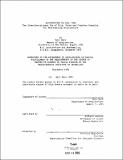| dc.contributor.advisor | Richard Leacock. | en_US |
| dc.contributor.author | Mark, Earl | en_US |
| dc.contributor.other | Massachusetts Institute of Technology. Dept. of Architecture. | en_US |
| dc.date.accessioned | 2013-01-07T21:11:07Z | |
| dc.date.available | 2013-01-07T21:11:07Z | |
| dc.date.copyright | 1985 | en_US |
| dc.date.issued | 1985 | en_US |
| dc.identifier.uri | http://hdl.handle.net/1721.1/75984 | |
| dc.description | Thesis (M.S.V.S.)--Massachusetts Institute of Technology, Dept. of Architecture, 1985. | en_US |
| dc.description | MICROFICHE COPY AVAILABLE IN ARCHIVES AND ROTCH | en_US |
| dc.description | Includes bibliographical references (leaves 68-69). | en_US |
| dc.description.abstract | This thesis examines the interdisciplinary application of film, video and computer graphics to architecture. Three projects provide the basis of research: 1) An "interactive" videodisc of the design and construction of the Sagrada Familia Temple in Barcelona. 2) A videotape sketch of an urban space, "Trinity Church", December 1982. 3) Slow scan transmission of video images between Copley Square and the computer graphics lab of the Visible Language Workshop, M.I.T., April 1982. They investigate the potential of a media technology that is non-traditional for architects to: 1) Document the Design and Construction of contemporary building. (Projects 1 and 2) 2) Be used to assess the social and environmental impact of architecture and urban design. (Projects 2 and 3) 3) Communicate the pathos, cultural qualities, observable symbols and images of architecture and urban design. (Projects 1 and 2) 4) Document or creatively express a~chitecture through: (a) Computer 3-D Animation. (Project 1 ) (b) Computer Painting. (Projects 1 & 3) (c) Film Animation. (Projects 1 & 2 ) (d) Film Production. (Projects 1 & 2 ) (e) Slow Scan Transmission. (Project 3) (f) Sound Recording. (Projects 1 & 2 ) (g) Video Production. (Project 1) (h) Interactive Videodisc . (Project 1 ) A comparison with more traditional media (e.g. pencil on paper) will be used to assess the relative strengths and weaknesses of the new media tools. The pedagogical role of media for architects focuses the assessment.The approach within this document is more topical than technical. Technical materials developed for the above projects, such as source code by this thesis candidate, are for the most part immaterial to the nature of these findings with one exception . The design of a relational and hierarchical database for making videodisc technology an integrative medium is summarized. | en_US |
| dc.description.statementofresponsibility | by Earl Mark. | en_US |
| dc.format.extent | 69 leaves | en_US |
| dc.language.iso | eng | en_US |
| dc.publisher | Massachusetts Institute of Technology | en_US |
| dc.rights | M.I.T. theses are protected by
copyright. They may be viewed from this source for any purpose, but
reproduction or distribution in any format is prohibited without written
permission. See provided URL for inquiries about permission. | en_US |
| dc.rights.uri | http://dspace.mit.edu/handle/1721.1/7582 | en_US |
| dc.subject | Architecture. | en_US |
| dc.title | Architecture in real time : the interdisciplinary use of film, video and computer graphics for representing architecture | en_US |
| dc.title.alternative | Interdisciplinary use of film, video and computer graphics for representing architecture | en_US |
| dc.type | Thesis | en_US |
| dc.description.degree | M.S.V.S. | en_US |
| dc.contributor.department | Massachusetts Institute of Technology. Department of Architecture | |
| dc.identifier.oclc | 15805677 | en_US |
